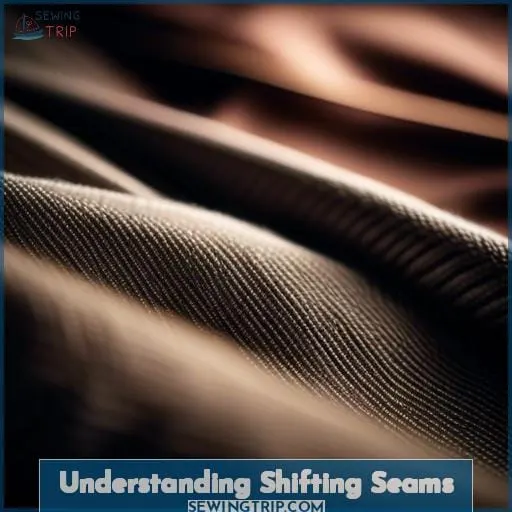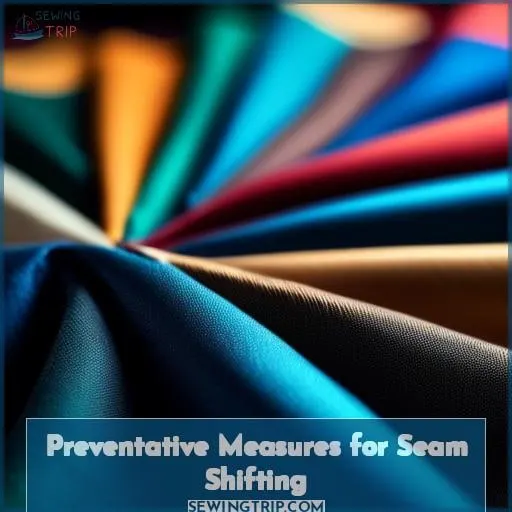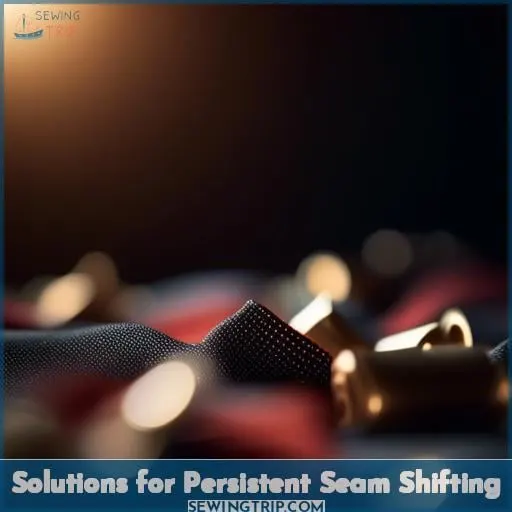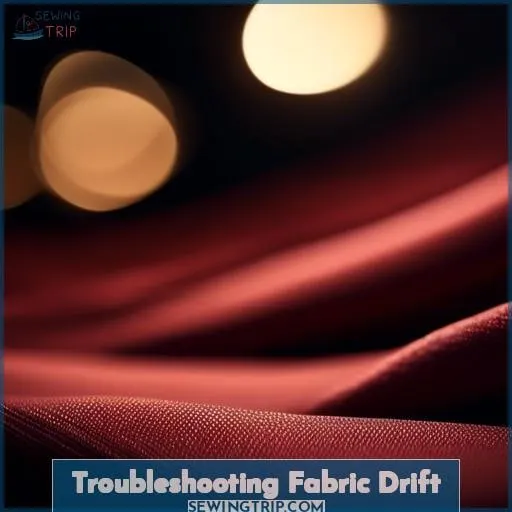This site is supported by our readers. We may earn a commission, at no cost to you, if you purchase through links.
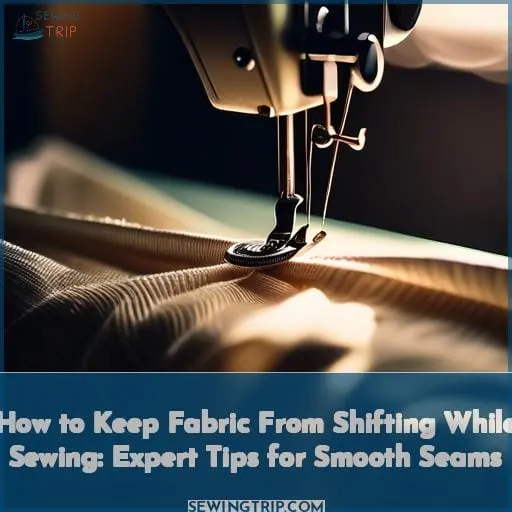
If you’re battling shifting fabric, you’re not alone. This guide will arm you with expert tips to keep your fabric from shifting while sewing, ensuring smooth seams every time.
From understanding why seams shift to employing advanced techniques for slippery fabrics, we’ll cover machine settings, sewing techniques, and the use of sewing aids like walking feet and temporary adhesives.
Whether you’re a beginner or seasoned sewist, these strategies will help you achieve mastery over your materials, giving you the control and understanding needed to tackle any project with confidence.
Table Of Contents
Key Takeaways
- Use a walking foot attachment to stabilize fabric layers and feed them evenly through the sewing machine, preventing the bottom layer from moving faster than the top.
- Apply temporary adhesives like glue sticks or spray adhesives within the seam allowance to hold fabric layers together before sewing, ensuring they do not shift during the process.
- Adjust sewing machine settings such as stitch length and presser foot pressure to suit the specific fabric being sewn, helping to minimize fabric shifting.
- Hand baste slippery or difficult fabrics with a running or whip stitch before machine sewing to secure the layers together and prevent shifting.
How to Keep Fabric From Shifting While Sewing
To prevent fabric from shifting while sewing, use a walking foot attachment or hold the fabric taut and guide it evenly through the machine.
Understanding Shifting Seams
Expert Tips for Smooth Seams
Ever felt like you’re wrestling a slippery eel instead of sewing fabric? You’re not alone. Shifting seams are the bane of many a sewer’s existence, turning what should be a smooth sailing project into a frustrating game of tug-of-war.
But why does this happen? It’s all about the dance between your fabric and the sewing machine. Imagine your fabric layers as dance partners that aren’t quite in sync. The machine’s feed dogs grab the bottom layer and whisk it away, while the top layer lags behind, creating that dreaded shift.
It’s like trying to walk a puppy that suddenly stops to sniff every leaf, while you’re determined to march straight ahead.
But fear not, intrepid stitcher! The solution isn’t as elusive as a needle in a haystack. It’s about mastering the art of control and understanding the quirks of your sewing machine. Think of it as becoming the conductor of an orchestra, where every instrument (or in this case, sewing tool) plays in perfect harmony.
From the presser foot pressure to the integrated even feed system, every element has a role in preventing those seams from shifting. So, grab your fabric, take a deep breath, and prepare to tame those shifting seams with the finesse of a sewing ninja.
Preventative Measures for Seam Shifting
To prevent your seams from shifting while you sew, it’s crucial to set your machine correctly and use the right techniques.
You’ll want to adjust your sewing machine’s settings and handle your fabric with care to ensure smooth, even seams.
Machine Settings
Adjusting your sewing machine settings can be a game-changer when it comes to preventing seam shifting.
- Needle Tension: Too tight or too loose can cause fabric to pucker or seams to stretch. Find the sweet spot for your fabric type.
- Stitch Length: Shorter stitches for delicate fabrics, longer for heavier ones. A general rule is 10-15 stitches per inch for most projects.
- Presser Foot Pressure: If adjustable, lighten for delicate fabrics to prevent dragging and ensure even feeding.
Sewing Techniques
Let’s dive into the crafty world of preventing fabric shifting! One trick is to get your machine singing in harmony with the fabric feed. An adjustable presser foot can be your maestro, guiding the fabric layers through the machine’s dance.
Don’t let seam alignment become a tango gone wrong! Pin it down like a pro, perpendicular to the edge. But remember, even the best dancers can miss a step sometimes, so be ready to catch any fabric that tries to sneak off the dance floor.
Solutions for Persistent Seam Shifting
If you’re struggling with seams that won’t stay put, a walking foot can be your saving grace.
It’s designed to stabilize your fabric, ensuring that every stitch lands just where you need it.
Walking Foot
If you’re still struggling with shifting seams, consider investing in a walking foot. This handy attachment moves both layers of fabric simultaneously, eliminating any slipping or distortion.
Its unique design ensures that even slippery fabrics like rayon or silk stay in place, giving you perfectly aligned seams every time. Plus, the adjustable settings allow you to customize the pressure and speed to suit your fabric and project.
Stabilizing Fabrics
In the quest for smooth seams, don’t overlook the power of fabric stabilizers. Think of interfacing, fusible tape, and basting spray as your sewing sidekicks.
They’re like the secret sauce that keeps everything in place. For those tricky moments, a dab of glue stick or a strip of tape can work wonders.
And remember, tissue paper isn’t just for gifts—it’s a seamstress’s ally, helping to tame unruly fabrics with ease.
Troubleshooting Fabric Drift
When it comes to troubleshooting fabric drift and keeping fabric from shifting while sewing, it’s crucial to focus on machine adjustments and the use of sewing aids.
If you’re facing issues with fabric shifting despite your best efforts, it’s time to consider tweaking your sewing machine settings and incorporating helpful sewing aids into your process.
These steps can significantly improve your sewing experience, ensuring smoother seams and more precise outcomes.
Machine Adjustments
Continuing from our previous discussion on preventing seam shifting, let’s dive into the nitty-gritty of machine adjustments. If you’re facing the dreaded fabric drift, it’s time to play detective with your sewing machine settings.
- Needle Positioning: Ensure it’s straight and aligned with your fabric edge.
- Pressure Foot Tension: Too tight, and your fabric won’t move; too loose, and it’ll dance away.
- Stitch Length: Match it to your fabric type for a harmonious sewing experience.
- Fabric Type: Some are divas and need special treatment, like a gentle hand or a specific sewing technique.
- Machine Settings: Sometimes, a little tweak here and there can make all the difference.
Sewing Aids
After tweaking your machine settings, it’s time to bring out the big guns: sewing aids. These little helpers can be game-changers. Think of them as your fabric’s best friends, keeping everything in line like a well-rehearsed dance troupe.
First off, don’t underestimate the power of the right needle size and thread tension. It’s like choosing the right shoes for a marathon; everything needs to be just right. And when it comes to presser foot pressure, it’s all about finding that sweet spot where your fabric neither feels squashed nor too free to roam.
Now, onto the heavy lifters: pattern weights and pins. These aren’t just tools; they’re your secret weapons against the dreaded shift. Imagine them as your fabric’s bodyguards, keeping everything in place without a fuss.
And for those tricky moments, a 3 x 5 card or glue adhesive can be your ace in the hole, guiding your fabric with precision and care.
So, keep your chin up and your fabric steady. With these aids by your side, you’re ready to tackle any shift that comes your way.
Advanced Techniques for Slippery Fabrics
When working with slippery fabrics, hand basting and using temporary adhesives can be game-changers. Hand basting with a running or whip stitch secures your layers together, ensuring they don’t shift during sewing.
For a quicker fix, a dab of glue stick within the seam allowance can hold fabrics in place until you’re ready to sew, and it washes out easily. These techniques offer you more control and precision, making your sewing experience smoother and more enjoyable.
Hand Basting
When tackling slippery fabrics, hand basting is your secret weapon for keeping everything in place. Think of it as your fabric’s best buddy, offering a helping hand to keep layers from dancing away from each other.
It’s like giving your fabric a gentle hug with a needle and thread, ensuring that every piece stays exactly where you want it. Whether you’re dealing with the sleekness of bemberg rayon or the trickiness of tissue paper sandwiches, hand basting allows you to adjust hand tension, needle size, and thread choice to match the fabric type and seam allowance perfectly.
So, before you dive into sewing, take a moment to baste by hand. It’s a small step that can save you from big headaches, making sure your project doesn’t slip through your fingers—literally!
Temporary Adhesives
After mastering hand basting, you might find temporary adhesives to be a game-changer for keeping those slippery fabrics in check.
When it comes to fabric preparation, a dab of adhesive can work wonders. Choose your adhesive selection wisely—sprays, sticks, or tapes, each has its own charm.
For application techniques, think of it as painting with precision; a light touch can prevent a sticky situation. And remember, removal methods are key; you want that fabric to part ways with the adhesive like a clean break-up, no messy residue left behind.
Keep it light-hearted, folks—no need to get stuck on the details!
Frequently Asked Questions (FAQs)
How to sew with metallic or sequined fabrics without shifting?
When sewing with metallic or sequined fabrics, ditch the frustration by first removing sequins from your seam allowances. This prep step is a game-changer, ensuring your machine needle glides through without a hiccup.
Opt for a simple pattern to let the fabric’s drama shine and keep a stash of extra needles handy—breaking one isn’t a matter of if, but when.
Can starch prevent fabric from shifting on lightweight materials?
A stitch in time saves nine, and using starch on lightweight materials can indeed prevent fabric from shifting.
It adds stiffness, making it easier to handle and sew, especially for intricate patterns.
So, yes, starch can be your secret weapon for keeping those pesky lightweight fabrics in place.
Best techniques for sewing circular or irregular shapes without fabric shifting?
To sew circular or irregular shapes without fabric shifting, use a walking foot, pin strategically, and hand baste for extra stability.
Go slow and steady, and don’t be afraid to make adjustments as you go.
How to adjust tension for different fabric types to prevent shifting?
Adjusting tension for different fabric types is like being a DJ for your sewing machine, spinning the dials to hit that perfect stitch harmony.
For thicker threads and heavier fabrics, loosen up that top tension like you’re relaxing into a comfy chair. Lighter fabrics? Tighten it slightly, as if you’re pulling your coat closer on a chilly evening.
Keep experimenting until your stitches sing in tune.
Is there a way to prevent fabric shifting when sewing without pins or clips?
To prevent fabric shifting without pins or clips, try taut sewing: hold the fabric firmly in front and behind the presser foot, moving your hands evenly as you sew.
No pulling, just smooth guiding!
Conclusion
With a stitch in time, you’ve woven through the fabric of sewing challenges, mastering the art of keeping fabric from shifting.
Embrace techniques like hand basting and temporary adhesives for those slippery contenders.
With a walking foot to guide you and stabilizers to support, every seam you sew will be a testament to your skill.
Now, go forth and craft with confidence, knowing that smooth seams are within your reach when you know how to keep fabric from shifting while sewing.

